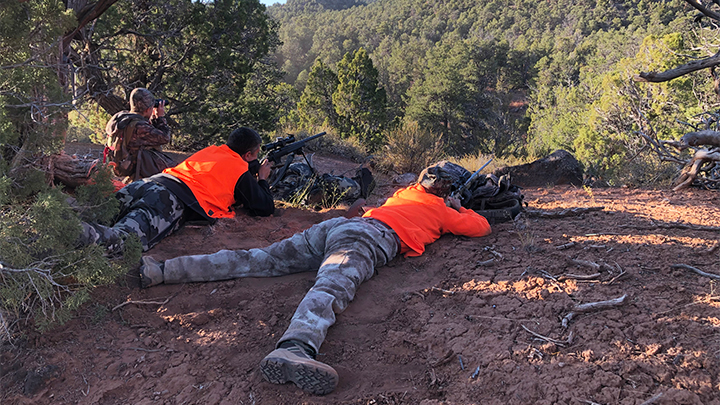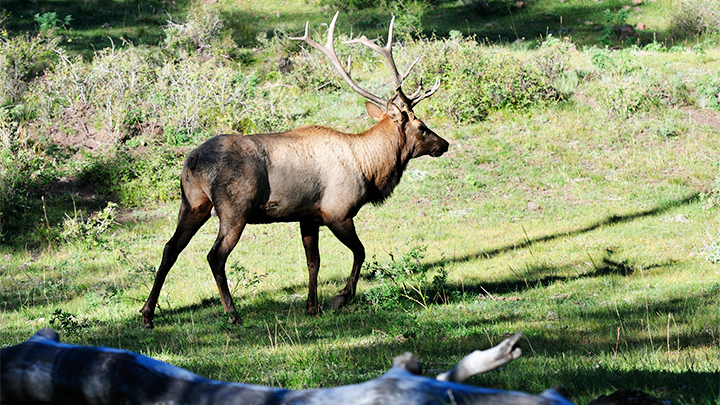
Late-afternoon sun lit the high-country meadow, reflecting off golden Aspen leaves like a vast sea of Spanish Doubloons. Four-hundred-and-eighty yards across the meadow a bull bugled aggressively, answered in turn by a dozen other bulls scattered across the mountainside. The rut was in full swing in this special-draw elk-hunting unit. I blew my Primos cow call.
From across the meadow the bull answered, and instantly I knew by his tone he would come. He did, striding from the timber and into the meadow, bugling every third step. I’ve called in perhaps half a thousand bulls over the years, and this setup stands out as one of the most spectacular I’ve ever seen. My friend Justin sat to my right, his loaded muzzleloader rested on a downed tree and a coveted elk tag in his pocket. I called again, and we watched the bull come, strutting across the meadow with complete abandon.
Situations like these are apt to rattle even the most seasoned hunters. The bull was big and massive, screaming bugles and coming right at us. Justin had been hunting hard for a week without luck, and we had just sprinted three miles up a mountainside to reach this meadow before dusk. The elk hunting gods were smiling on us—we’d hit the mother lode of the rut. Bulls were bugling and cows were chirping all around us; in a few short minutes Justin would be called on to make the most important shot of his life.

Physical Fitness
Elk tend to live in big, steep, high-elevation country. They also tend to be in superb physical condition, and don’t hesitate to run up big, steep mountains anytime they feel the urge. As elk hunters, we need to do our best to get in shape before an elk hunt. You’ll want to prepare in three areas:
Strength
Lower-body strength is the most important for an elk hunt. You’ll be called on to climb steep slopes with a pack on your shoulders day after day, so work out your legs. Squats and lunges are good, but climbing steep terrain with a pack on is better. If you don’t have hills or steep terrain in your area, long staircases make a good substitute. I prefer to work my legs out three days a week, allowing them to rest and heal on in-between days. Wear the boots you intend to hunt in while you exercise; that’ll break them in and toughen your feet for the rigors of the hunt.

Cardio
The difference between an elk opportunity won or lost is often decided by how fast you can climb a mountain. You might need to race a herd to a ridge-top saddle or beat feet across a mountainside to close within range for a shot. Do cardio training several times per week. If you’re a flatlander (living below 2,000 feet of elevation) the air seems mighty thin in most elk habitat, which is commonly 8,000 to 13,000 feet above sea level. It’s hard to believe, but you’ll only be able to walk as far at high elevation as you can run at home.
Packing Weight
Elk hunting almost always involves carrying a backpack, and if you’re fortunate enough to harvest an elk, will likely require you to carry heavy loads of meat out of some hard-to-get-to place. Prep your shoulders for the strain by carrying a pack while you hike hills or climb stairs. Start light with around 20 pounds of weight, and work up to about 40. Once a week for the last month carry 60-80 pounds. When the time comes to pack an elk out, you’ll be ready.

Mental Toughness
Elk hunting can be the most exciting hunting experience you’ll ever have. It can also be one of the hardest, most painful hunts you ever experience. Elk are nomadic by nature, live in a vast sea of mountains and work hard to avoid people. It’s common to hunt hard for days without seeing an elk. When that occurs it’s easy to start dreaming of a juicy hamburger in town and your soft bed at home. Don’t give up; forego the soft bed and juicy burger and stay mentally tough. If you’re not seeing elk, change tactics or relocate to more remote territory. Your fortunes in the elk woods can change in the blink of an eye.

In-the-Field Shooting Skills
I remember an autumn day years ago—I was riding my horse through a mountain saddle looking for cattle when I encountered a disconsolate hunter. The elk hunt was in progress, and this fellow had just experienced a close-up encounter with a big bull. He rushed the 60-yard broadside shot, and missed. The bull stuck around and offered him another opportunity. Shaking with “Bull” fever, he tried to rack another shell into his chamber. The rifle was a push-feed model, and the hunter caused a double-feed malfunction. The elk finally got tired of waiting and departed, leaving the hunter brokenhearted.
This situation, in every way, should have resulted in a big bull on the ground and a very excited hunter. But the fellow flubbed his first shot, as well as his second-chance opportunity. Needless to say, he should have refined his field shooting and rifle-handling skills. Here are three things you can do to avoid standing in his shoes:
Practice Field Positions
Learn correct prone, sitting and standing field positions, then practice rapidly assuming those positions. Train to utilize any available support: your pack, a stump, a log or rock, or the fork of a tree. Take your rifle on wood-walks, pick out targets to aim at (safely, of course), and rapidly get into the best available field position for a shot. This will teach you to survey your position and choose the best rock or stump, drop quickly into position, and find the target in your scope.

Dry-Fire Practice
Train to watch your crosshairs while you dry-fire your rifle. (Don’t worry; dry-firing a centerfire bolt-action rifle won’t hurt it.) The crosshairs should be stationary before the dry-fire “click,” and they should stay that way through and after the click. Practice until they stay steady and true every time you dry-fire.
Train for Follow-Up Shots
Wait one half-second after you dry-fire your rifle to establish good follow-through. Then instantly rack the bolt, never taking your eye from your on-target crosshairs. Steady the crosshairs again, and squeeze the trigger on a follow-up “click.” Repeat.
Put It All Together
First, add these three drills together. Take your rifle for a walk, pick out a target, assume a field position and dry fire, adding a follow-up click. Carry your pack. Hike rugged terrain, assume field positions (now you can add your pack as a shooting rest), and snap dry-fire and follow-up shots. Finally, repeat with live fire on real targets.

Shot Placement on Elk
Elk are big, heavy-boned animals. Furthermore, they possess tremendous vitality and will to live. Place your bullet well, and they expire rapidly with a minimum of objection. Place it poorly, and you’re likely to experience a difficult, heart-wrenching recovery effort.
Use Good Bullets
Simply put, maximize your chances by shooting only premium, deep-penetrating bullets at elk. That way you can ethically take tough shots, such as a quartered-toward or quartered-away shot where heavy bone shelters the vitals, and still expect sufficient penetration. Elk are tough; use tough bullets.
Get Steady
Do not squeeze the trigger until you’ve found a good shooting position and your crosshairs are steady on the elk’s vitals. If you’re not steady, find a better position, get steady, then shoot.

Stay Calm
This can be difficult to do. Two things can help: before the hunt, visualize (daydream) a big bull presenting a shot. Visualize the entire experience, while mentally staying ice-cold through the shot and until the bull is down. Repeat, changing the scenario a bit. This will help train your mind and establish a precedent before the real experience ever occurs. Second, learn breathing exercises in case your adrenaline takes over. Here’s one that military special-forces use: Breathe in for a count of four, hold for a count of four, exhale for a count of four. Repeat three times. It’ll calm your heartbeat and respiratory rate, and can be repeated as necessary. Lastly, if you simply cannot get yourself calm, don’t shoot. It’s better to leave the bull undisturbed and hope for another opportunity than to miss or wound him with a bad shot because you couldn’t get your nerves under control.
Trigger Wisely
The final ingredient to making a successful shot is a wise hand on the trigger. Don’t take a distant running shot, or shoot at a patch of tan through the timber. Don’t shoot until you have your breathing in hand and your crosshairs steady. That said, elk hunting requires hard effort, much heart and tough shooting to be successful. Don’t hesitate to press that trigger if you’re confident you can kill the elk. Opportunities are hard-earned and usually fleeting. Get in position, settle down and kill that bull.

Conclusion
Still bugling, the huge bull strode across the meadow, occasionally breaking into a trot. Nearing our hiding spot in the treeline he slowed, turning his massive antlers, searching for the sweet-sounding cow he’d been hearing. I glanced at Justin, glued to his riflescope, watching the bull. He appeared calm. At 80 yards the bull stopped, slightly quartered-on. Justin’s muzzleloader boomed its message into the meadow, and the bull dropped where he stood. Justin had held it together and harvested the bull of a lifetime after watching it bugle its way across 400 yards of yellow-grass meadow.




































